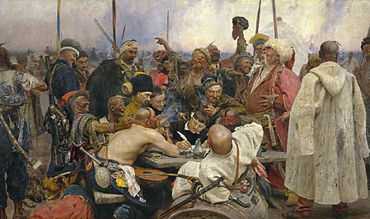Koliyivshchyna
| Koliyivshchyna rebellion | |||||||
|---|---|---|---|---|---|---|---|
Camp of Haidamakas | |||||||
| |||||||
| Belligerents | |||||||
|
| Haidamaky | ||||||
| Commanders and leaders | |||||||
|
Mikhail Krechetnikov Jan Klemens Branicki |
Maksym Zalizniak Ivan Gonta | ||||||
| Part of a series on |
| Cossacks |
|---|
 |
| Cossack hosts |
| Other groups |
| History |
| Cossacks |
| Cossack terms |
Koliyivshchyna 1768-1769 (Ukrainian: Коліївщина, from Ukr. "impaling") was a Ukrainian Cossack and peasant rebellion against Poland and retaliation of the Bar Confederation pogroms against Ukrainians. While this rebellion may have begun with the aim of stopping social, national, and religious oppression of Ukrainians, it rapidly became a full-fledged campaign of ethnic cleansing aimed against Poles, Jews, and non-Orthodox Ukrainians.
It was simultaneous to the Confederation of Bar and a de facto civil war in Poland (Poland had during the rule of king Augustus III an internal policy of imposition of Catholicism on non-Catholic population. When the king Stanisław August Poniatowski, under the pressure of the Russian Crown, signed the document in which Orthodox was equated in rights with Catholicism, szlachta rebelled). It is unclear whether the hostilities were started by the Catholic or Orthodox paramilitary units. Some historians have stated that Russia may have had a role in fomenting the rebellion and the fact that Ukrainian Uniates were among its victims adds credence to this interpretation. The rebellion was fueled by the circulation of letter ostensibly written by the Empress Katherine of Russia, in which she promised military help if Ukrainians rise against the Poles.
The peasant rebellion quickly gained momentum and spread over the territory from the right bank of the Dnieper River to the river Syan. At Uman it led to a massacre of legendary proportions. Poles, Jews and Uniates were herded into their churches and synagogues and killed in cold blood. In three weeks of unbridled violence the rebels slaughtered 20,000 people, according to numerous Polish sources. The leaders of the uprising were Cossacks Maksym Zalizniak and Ivan Gonta. The latter was a Registered Cossack who changed sides and joined Zalizniak at Uman while being sent by Polish Count Franciszek Salezy Potocki to protect it. Gonta was in fact а sotnyk (i.e. a commander of a unit of 100 sabers) of the Uman Regiment.
The rebellion was suppressed by the joint forces of Polish and Russian armies, with numerous hangings, decapitations, quarterings and impalings.[1]
Casualties
According to numerous Polish sources, the total number of casualties of the Koliyivshchyna 1768 on the right-bank Ukraine is estimated at 200,000 murdered people, mainly Poles and Jews.[1] Testimonies and reports of the witnesses and those who managed to survive give evidence of unbelievable cruelty of the perpetrators.
Koliyivshchyna in popular culture
Taras Shevchenko's epic poem Haidamaky (The Haidamakas) chronicles the events of the Koliyivshchnyna.
References
Further reading
- Magocsi, Paul Robert (1996). A History of Ukraine. Toronto: University of Toronto Press. ISBN 0-8020-0830-5.
- Henryk Mościcki, "Z dziejów hajdamacczyzny", Warszawa 1905
- Władysław Andrzej Serczyk, "Koliszczyzna", Kraków 1968
- Władysław Andrzej Serczyk, "Hajdamacy", Wydawnictwo Literackie, Kraków 1972
- Karol Grunberg, Bolesław Sprengel, Trudne sąsiedztwo, Warszawa 2005
- Władysław Wielhorski, Ziemie ukrainne Rzeczypospolitej: Zarys dziejów, Londyn 1959
- Kazimierz Karolczak, Franciszek Leśniak, "Wielka Historia Polski", Kraków 1998
- "Dzieje Polski. Kalendarium", pod red. Andrzeja Chwalby, Kraków 1999
- "Kronika Polski", praca zbiorowa, Warszawa 200
- Stanisław Bogusław Lenard, Ireneusz Wywiał, Historia Polski w datach, wyd. PWN, Warszawa 2000
| ||||||||